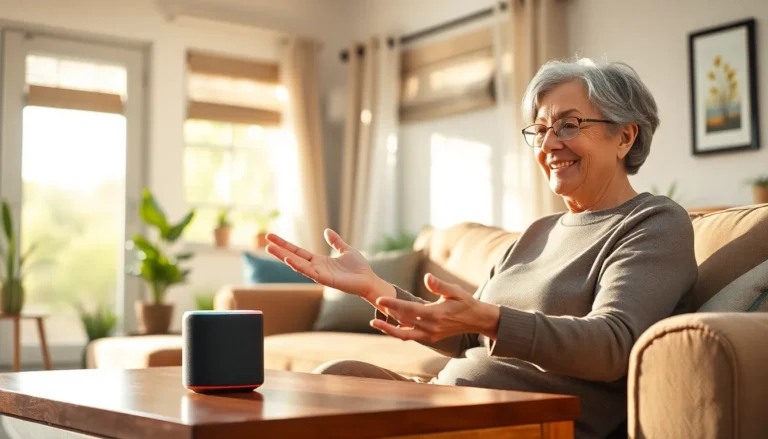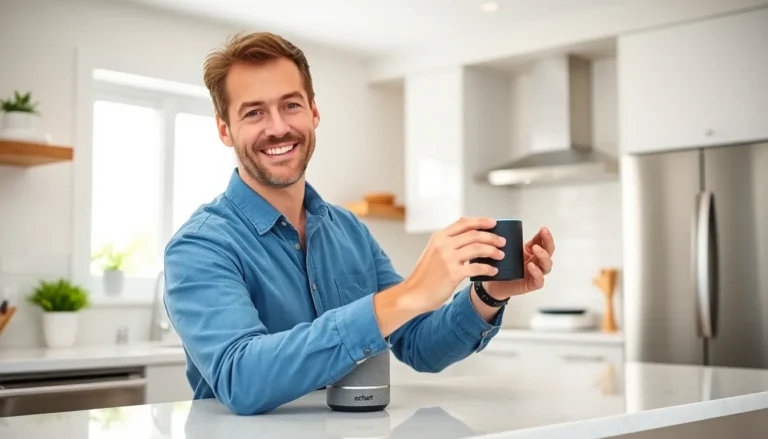Table of Contents
ToggleAs technology zooms ahead at breakneck speed, seniors often find themselves in a race they didn’t sign up for. But fear not! Smart home devices are here to save the day, transforming everyday living into a seamless blend of comfort and convenience. Imagine controlling lights, thermostats, and even the coffee maker with just a few simple commands. It’s like having a personal assistant who never forgets your birthday!
These gadgets aren’t just for tech-savvy whippersnappers; they’re designed with seniors in mind. From voice-activated systems to easy-to-use interfaces, smart home devices bring safety and independence right to their fingertips. So why not make life a little easier and a lot more fun? Embrace the future and discover how these clever tools can help seniors navigate their golden years with style and a sprinkle of humor.
Benefits Of Smart Home Devices For Seniors
Smart home devices offer numerous advantages that enhance the quality of life for seniors. These technologies contribute to increased independence and overall well-being.
Improved Safety And Security
Enhanced safety features significantly benefit seniors using smart home devices. Smart security cameras offer real-time monitoring, providing peace of mind for both seniors and family members. Remote door locks allow for secure access control, so seniors can let caregivers or family members in without compromising safety. Smart sensors can detect falls or unusual activity, sending alerts to emergency contacts, thereby ensuring timely assistance. Moreover, smart smoke detectors provide early warnings, reducing the risk of fire-related incidents.
Enhanced Convenience And Accessibility
Seniors enjoy greater convenience with smart home devices that streamline everyday tasks. Voice-activated assistants enable hands-free control over lights, thermostats, and appliances, making operations simpler for those with mobility challenges. Smart plugs allow seniors to remotely switch on or off devices, ensuring they manage energy consumption effectively. Additionally, customized reminders for medication or appointments can be set up, promoting health management. These features collectively improve daily living, making environments more accessible and user-friendly.
Popular Smart Home Devices For Seniors

Smart home devices greatly enhance daily living for seniors. These technologies are tailored to improve safety, convenience, and overall quality of life.
Smart Speakers And Voice Assistants
Smart speakers and voice assistants allow seniors to control their homes effortlessly. They can play music, set reminders, or access information hands-free. Many devices integrate with other smart home equipment, enabling users to adjust thermostats and lights using simple voice commands. Popular options include Amazon Echo and Google Nest. These devices offer easy access to emergency contacts, promoting security and connectivity.
Smart Lighting Systems
Smart lighting systems enhance visibility and safety for seniors. They provide customizable brightness settings, automated schedules, and mood lighting features. Seniors can use voice commands or smartphone apps to control lights throughout the home, ensuring that areas are well-lit when needed. Moreover, motion sensors automatically activate lights when someone enters a room, reducing the risk of falls. Systems like Philips Hue and LIFX are favorites among users.
Smart Security Cameras
Smart security cameras offer peace of mind to seniors and their families. These cameras feature real-time monitoring, allowing users to check in on their homes from anywhere. Some models include motion detection and alerts, providing timely notifications of unusual activity. Two-way audio lets seniors communicate with visitors at their doors. Popular brands such as Ring and Arlo provide user-friendly interfaces that maintain straightforward accessibility.
Smart Health Monitoring Devices
Smart health monitoring devices play a key role in promoting seniors’ wellness. Wearable technology, like smartwatches and fitness trackers, can monitor heart rates, activity levels, and sleep patterns. Some devices also send real-time updates to caregivers or family members, aiding in proactive health management. Blood pressure monitors and glucose meters with smart features allow for better tracking of health metrics. Devices from brands like Fitbit and Apple facilitate daily health monitoring and offer reminders for medication.
How To Choose The Right Smart Home Devices
Selecting the right smart home devices requires careful consideration of individual needs and compatibility with existing systems.
Assessing Individual Needs
Evaluate personal requirements before purchasing smart home devices. Consider mobility limitations; devices that simplify tasks can enhance independence. Think about safety features; smart smoke detectors and security cameras provide crucial protection. Understand the user’s tech comfort level; intuitive interfaces suit those less familiar with technology. Prioritize devices that offer health management, like wearables that track vital signs. Gathering feedback from family members can also aid decision-making. Matching devices to lifestyle improves usability and overall satisfaction.
Compatibility With Existing Systems
Confirm that new devices integrate with current home systems. Check for compatibility with smart hubs; popular brands often work together seamlessly. Explore Wi-Fi connectivity; most devices require strong internet signals for optimal performance. Investigate voice assistant compatibility; many seniors benefit from hands-free control. Review app interfaces for ease of use; user-friendly applications increase engagement. Ensuring all systems communicate effectively enhances functionality and makes daily living simpler.
Tips For Setting Up Smart Home Devices
Setting up smart home devices can significantly enhance the quality of life for seniors. Effective installation and proper training ensure these technologies become valuable allies in everyday tasks.
User-Friendly Installation
Choosing devices with straightforward installation processes simplifies setup. Many products offer step-by-step guides and video tutorials that facilitate understanding. Smart devices often utilize mobile apps for seamless configuration. Consider devices with plug-and-play features that require minimal technical knowledge. Scheduling installation during light traffic times can reduce stress. Familiarizing oneself with the device’s functions before installation increases confidence. Neighbors or family members can lend assistance if technical challenges arise.
Providing Ongoing Support And Training
Ongoing support and training are crucial for maximizing device usability. Regular check-ins can help seniors feel comfortable with their devices. Family members can lead hands-on training sessions to reinforce learning. Online resources, including communities and forums, provide valuable help when needed. Apps frequently update, so understanding new features enhances functionality. Encourage seniors to ask questions and express concerns about device use. Setting up user-friendly guides simplifies everyday tasks and reinforces independence.
Smart home devices offer invaluable support for seniors looking to enhance their quality of life. With user-friendly designs and advanced safety features these technologies empower seniors to maintain independence while ensuring peace of mind for both them and their families.
By integrating smart devices into daily routines seniors can easily manage their homes and stay connected with loved ones. The right smart home solutions not only simplify tasks but also promote health and safety. Embracing these innovations can transform everyday living into a more enjoyable experience. As technology continues to evolve seniors are well-positioned to benefit from these advancements and navigate their later years with confidence and ease.







